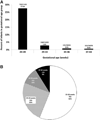Varying patterns of home oxygen use in infants at 23-43 weeks' gestation discharged from United States neonatal intensive care units
- PMID: 23769504
- PMCID: PMC4027028
- DOI: 10.1016/j.jpeds.2013.04.067
Varying patterns of home oxygen use in infants at 23-43 weeks' gestation discharged from United States neonatal intensive care units
Abstract
Objectives: To compare proportions of infants at different gestational ages discharged from the neonatal intensive care unit (NICU) on home oxygen, to determine how many were classified with chronic lung disease based on timing of discharge on home oxygen, and to determine the percentage discharged on home oxygen who received mechanical ventilation.
Study design: We evaluated a retrospective cohort of infants of 23-43 weeks' gestational age discharged from 228 NICUs in 2009, using the Pediatrix Clinical Data Warehouse. Multilevel logistic regression analysis identified predictors of home oxygen use among extremely preterm, early-moderate preterm, late preterm, and term infants. Duration of mechanical ventilation and median length of stay were calculated for infants discharged on home oxygen.
Results: For the 48877 infants studied, the rate of home oxygen use ranged from 28% (722 of 2621) in extremely preterm infants to 0.7% (246 of 34 934) in late preterm and term infants. Extremely preterm infants composed 56% (722 of 1286) of the infants discharged on home oxygen; late preterm and term infants, 19% (246 of 1286). After gestational age, mechanical ventilation was the main predictor of home oxygen use; however, 61% of the late preterm and term infants discharged on home oxygen did not receive ventilation. The median length of hospital stay was 95 days (IQR, 76-114 days) for extremely preterm infants discharged on home oxygen, but only 15 days (IQR, 10-22 days) for late preterm and term ventilated infants discharged on home oxygen.
Conclusion: Although home oxygen use is uncommon in later-gestation infants, the greater overall numbers of later-gestation infants contribute significantly to the increased need for home oxygen for infants at NICU discharge. Neither respiratory failure nor lengthy hospitalization is a prerequisite for home oxygen use at later gestational age.
Keywords: AUC; Area under the curve; BPD; Bronchopulmonary dysplasia; CLD; Chronic lung disease; MAS; Meconium aspiration syndrome; NICU; Neonatal intensive care unit; PPHN; Persistent pulmonary hypertension of the newborn; ROC; Receiver operating characteristic.
Copyright © 2013 Mosby, Inc. All rights reserved.
Conflict of interest statement
The authors declare no conflicts of interest.
Figures


Similar articles
-
Parents' experiences of transition when their infants are discharged from the Neonatal Intensive Care Unit: a systematic review protocol.JBI Database System Rev Implement Rep. 2015 Oct;13(10):123-32. doi: 10.11124/jbisrir-2015-2287. JBI Database System Rev Implement Rep. 2015. PMID: 26571288
-
Duration of mechanical ventilation and prediction of bronchopulmonary dysplasia and home oxygen in extremely preterm infants.Acta Paediatr. 2021 Jul;110(7):2052-2058. doi: 10.1111/apa.15801. Epub 2021 Feb 15. Acta Paediatr. 2021. PMID: 33555069
-
Association Between Neonatal Intensive Care Unit Type and Quality of Care in Moderate and Late Preterm Infants.JAMA Pediatr. 2023 Mar 1;177(3):278-285. doi: 10.1001/jamapediatrics.2022.5213. JAMA Pediatr. 2023. PMID: 36648939 Free PMC article.
-
Inhalation or instillation of steroids for the prevention of bronchopulmonary dysplasia.Neonatology. 2015;107(4):358-9. doi: 10.1159/000381132. Epub 2015 Jun 5. Neonatology. 2015. PMID: 26044104 Review.
-
Outcomes for extremely premature infants.Anesth Analg. 2015 Jun;120(6):1337-51. doi: 10.1213/ANE.0000000000000705. Anesth Analg. 2015. PMID: 25988638 Free PMC article. Review.
Cited by
-
Trends in the Incidence of Bronchopulmonary Dysplasia after the Introduction of Neurally Adjusted Ventilatory Assist (NAVA).Children (Basel). 2024 Jan 17;11(1):113. doi: 10.3390/children11010113. Children (Basel). 2024. PMID: 38255426 Free PMC article.
-
Home Oxygen Use and 1-Year Readmission among Infants Born Preterm with Bronchopulmonary Dysplasia Discharged from Children's Hospital Neonatal Intensive Care Units.J Pediatr. 2020 May;220:40-48.e5. doi: 10.1016/j.jpeds.2020.01.018. Epub 2020 Feb 21. J Pediatr. 2020. PMID: 32093927 Free PMC article.
-
Need for supplemental oxygen at discharge in infants with bronchopulmonary dysplasia is not associated with worse neurodevelopmental outcomes at 3 years corrected age.PLoS One. 2014 Mar 19;9(3):e90843. doi: 10.1371/journal.pone.0090843. eCollection 2014. PLoS One. 2014. PMID: 24646665 Free PMC article.
-
Home Oxygen Use for Preterm Infants with Bronchopulmonary Dysplasia in California.J Pediatr. 2019 Jul;210:55-62.e1. doi: 10.1016/j.jpeds.2019.03.021. Epub 2019 Apr 12. J Pediatr. 2019. PMID: 30987778 Free PMC article.
-
Cost comparison of mechanically ventilated patients across the age span.J Perinatol. 2015 Dec;35(12):1020-6. doi: 10.1038/jp.2015.131. Epub 2015 Oct 15. J Perinatol. 2015. PMID: 26468935 Free PMC article.
References
-
- Underwood MA, Danielsen B, Gilbert WM. Cost, causes and rates of re-hospitalization of preterm infants. J Perinatol. 2007;27:614–619. - PubMed
-
- Hack M, Taylor G, Drotar G, Schluchter M, Cartar L, Andreias L, et al. Chronic conditions, functional limitations, and special health care needs of school-aged children born with extremely-low-birth-weight in the 1990s. JAMA. 2005;294:318–325. - PubMed
-
- Shapiro-Mendoza CK, Tomashek KM, Kotelchuck M, Barfield W, Nannini A, Weiss J, et al. Effect of late-preterm birth and maternal medical conditions on newborn morbidity risk. Pediatrics. 2008;121:e223–e232. - PubMed
-
- Bird TM, Bronstein JM, Hall RW, Lowery CL, Nugent R, Mays GP. Late preterm infants: birth outcomes and health care utilization in the first year. Pediatrics. 2010;126:e311–e319. - PubMed
-
- Newacheck PW, Inkelas M, Kim SE. Health services use and health care expenditures for children with disabilities. Pediatrics. 2004;114:79–85. - PubMed
Publication types
MeSH terms
Substances
Grants and funding
LinkOut - more resources
Full Text Sources
Other Literature Sources

